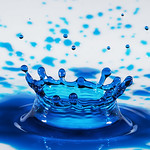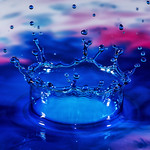How I Took Photos of Water Crown
We can see water crown right after a water drop hits the water. So we have to take picture right after a water drop hits the water. It takes me about 20 milliseconds.
To do it in auto mode I use my camera with flash and Arduino. I use LDR and laser pointer to capture a water drop and IR led to trigger camera. The main thing is you have to capture a water drop while fooling down.
My algorithm is very simple, I have read data from LDR in infinite loop and when value was less then N (depending on light in room) I wait for M milliseconds (depending on distance to plate) and send signal to take a picture.
First version of my “catcher” in second version I haven’t used IR-led instead of that I bought IR remote control and connect it to arduino because IR-led works fine with Nikon D80 but not with D750.
#define ldrPin 0
#define ledPin 12
#define sPin 13
void setup() {
Serial.begin(9600);
//pinMode(ldrPin, INPUT);
pinMode(ledPin, OUTPUT);
}
void loop() {
int val = analogRead(ldrPin);
if (val < 150) {
digitalWrite(sPin, HIGH);
delay(25);
sendNikonCode();
Serial.print(val);
Serial.println(" take picture");
digitalWrite(sPin, LOW);
delay(5000);
}
Serial.println(val);
}
void pulseIR(long microsecs) {
// we'll count down from the number of microseconds we are told to wait
cli(); // this turns off any background interrupts
while (microsecs > 0) {
// 38 kHz is about 13 microseconds high and 13 microseconds low
digitalWrite(ledPin, HIGH); // this takes about 3 microseconds to happen
delayMicroseconds(10); // hang out for 10 microseconds, you can also change this to 9 if its not working
digitalWrite(ledPin, LOW); // this also takes about 3 microseconds
delayMicroseconds(10); // hang out for 10 microseconds, you can also change this to 9 if its not working
// so 26 microseconds altogether
microsecs -= 26;
}
sei(); // this turns them back on
}
void sendNikonCode() {
// This is the code for my particular Nikon, for others use the tutorial
// to 'grab' the proper code from the remote
pulseIR(2080);
delay(27);
pulseIR(440);
delayMicroseconds(1500);
pulseIR(460);
delayMicroseconds(3440);
pulseIR(480);
delay(65); // wait 65 milliseconds before sending it again
pulseIR(2000);
delay(27);
pulseIR(440);
delayMicroseconds(1500);
pulseIR(460);
delayMicroseconds(3440);
pulseIR(480);
}
code of triggering camera was taken from http://sebastian.setz.name/arduino/my-libraries/multi-camera-ir-control/

